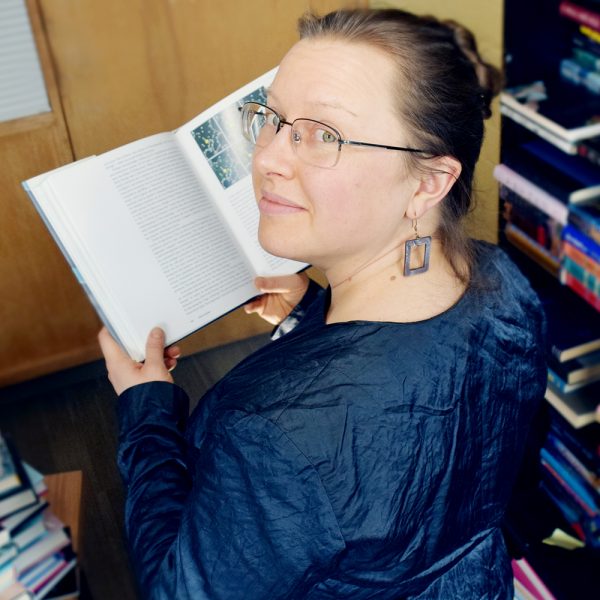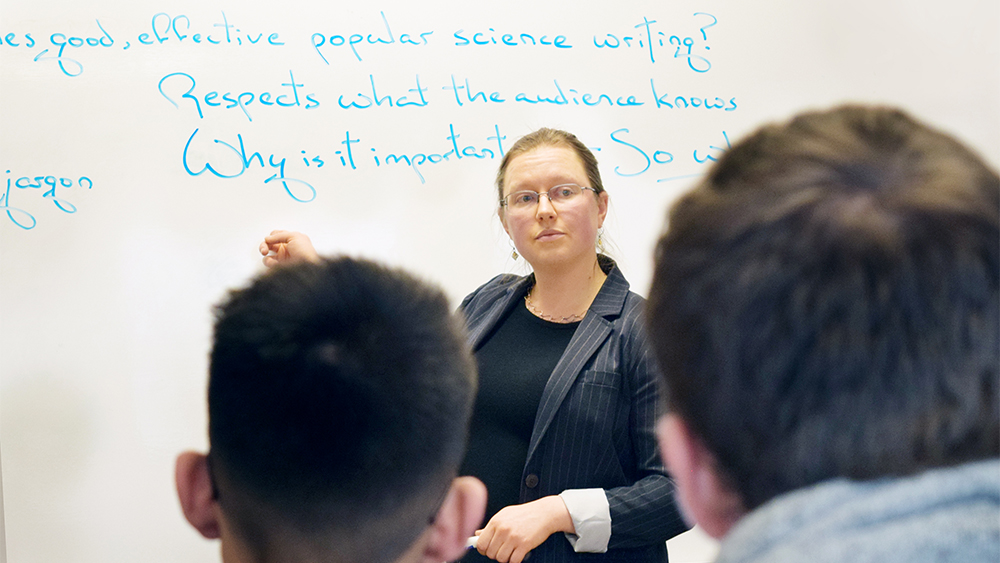Erika Szymanski studies how our perception of microbiomes can shape reality
By Gabe Saldana
Erika Szymanski tries to make the invisible visible. That’s a challenge when you study microbes, some of which are too small for even a high-powered microscope to observe. Yet the trajectory of human civilization is intertwined with microbes that we cannot see. How do we understand that concept? Szymanski uses words.
Her mission is to study our understanding of microbiomes and our interactions with them through how we write and speak about them. She thinks about how human perception can shape the fates of microbiomes and what humans can do with them.
The way people communicate about invisible or abstract concepts defines those concepts, and it determines how we interact with them for better or worse.
A microbiome, broadly, is the mixed community of microbes in an environment. But microbiomes become different things as humans continue to study and work with them in more nuanced ways.
“We’re talking about something that doesn’t have an immediately graspable identity in science or society,” Szymanski said. “The words we use to bring microbiomes into being really matter to the kinds of questions we ask about them and the kinds of problems they can be used to solve.”

Interdisciplinarity
Szymanski is assistant professor of rhetoric of science in the Department of English at Colorado State University, and she is the first humanities faculty member of the university-wide Microbiome Network. While rhetoricians of science studying microbiomes can be found in other university English departments, Szymanski’s hire distinguishes CSU’s Microbiome Network from the other US networks.
“What I would like to see with this position is that… we’re a leader in the communication of the science, understanding how we communicate among ourselves in the microbiome sciences,” said Jan Leach, Microbiome Network founding member and associate dean for research in the College of Agricultural Sciences.
Szymanski holds master’s degrees in microbiology and in rhetoric and composition. She also brings a Ph.D. in science communication. As a postdoctoral research fellow, she studied the rhetoric around building a synthetic genome for baker’s yeast.
 Her experience brings great interdisciplinary value to the Microbiome Network and to the English department, said department chair Louann Reid.
Her experience brings great interdisciplinary value to the Microbiome Network and to the English department, said department chair Louann Reid.
In the past several years, English has fostered collaborations between the sciences and humanities, Reid said.
“We developed a course in writing in the sciences and have offered team-taught classes in some aspect of writing or literature and some aspect of science. Dan Beachy-Quick (professor and assistant English department chair) also hosted a workgroup and a summer symposium called ‘Crisis and Creativity’ with a good mix of members from the humanities and the sciences,” Reid said.
But Szymanski is unique in her formal education and working backgrounds in both.
“What Erika can do is bridge those areas with her specializations,” Reid said. “She can speak in language that the scientists understand, and she can speak in language that they want to understand.”
That language includes metaphor, said Ed Hall, Ph.D., assistant professor of microbial ecology. He and other members of the Microbiome Network will investigate how language choices affect understanding of emerging concepts.
“Getting a rhetorician on board,” Hall said, “is this idea that our understanding is coupled to our language. We think we may be asking questions in one way, using metaphors, but metaphors carry baggage we’re not aware of, and when metaphors fall short (of a full description) our actual ability to learn more falls short.”
For example, Hall said, one might use a car and its parts to describe the broad structure and function of a microbiome. But, because cars don’t operate precisely like microbiomes, shared understanding must fill in what the metaphor cannot describe.
Are people sharing and interpreting metaphors as they were intended? What are the ramifications of misinterpretation among scientists and beyond the lab?
This is the focus of Szymanski’s research.
A discursive immersion
She also investigates how people interact with microbiomes in day-to-day life or as part of a vocation.
“I interview people to find out how they think about the kinds of terms that I’m reading, or how they think about the work they’re doing. What types of things come up when you talk about engineering a microbiome for example? What perceptions come along with that type of language?”
She says language and perception are critical to positioning humans as intertwined with living communities, as opposed to existing “above” them.
“Microbes are this tremendously rich case for thinking about how humans interact with things that are very different from us that we might not even have thought of as being alive,” Szymanski said.
She calls her studies a discursive immersion, and she sees her interdisciplinary experience as a tool for connecting diverse audiences to new lines of thought.
“Today we’re dealing with ramifications of not having thought about humans as relying on the earth, of not having thought of humans as interdependent,” she said. “My work is about how we position ourselves in the world as people, about who humans want to be, and about how we can take better care of those around us.”
The future
Ben Withers, dean of the College of Liberal Arts, said bringing Szymanski aboard with the Microbiome Network is the culmination of decades of work by individual faculty members in the college to cross disciplines with collaborations in climate change, food systems, and water issues among others.
Szymanski’s hiring, Withers said, brings university organizational structure and stronger funding support to interdisciplinary collaboration in “a realization from others of the successes we’ve accomplished on our own.”
This semester, Szymanski continues getting to know the English department as she advises students and teaches intermediate courses in rhetoric of sciences.

As her interactions with the Microbiome Network increase, Szymanski aims to develop additional courses in rhetoric of sciences as well as environmental humanities. Szymanski will speak at CSU as part of the Microbiome Network seminars on Feb. 12 from 4-5 p.m. in Clark A203. She also will speak at the American Society of Microbiology meeting in Chicago in 2020.
Overall, Szymanski works to fill a growing need in science to include social dimensions during and after research, looking at how people frame concepts as they emerge then leave the lab.
“We want to continue asking these questions about how we rethink some of the relationships we have with the environment and with other species,” she said. “A lot of that interest is focused around microbes.”
The Department of English is part of the College of Liberal Arts at Colorado State University.
The Microbiome Network is a campus-wide web of multidisciplinary scholars investigating the properties of microbiomes and how they function. They study microbiomes’ ecological relevance and their interactions with humans, animals, plants, soil and environments.